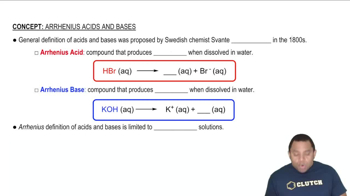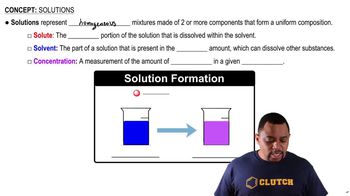(a) Do colloids made only of gases exist? Why or why not?
State whether each of the following statements is true or false. Justify your answer in each case. (b) When ammonium nitrate, NH4NO3, dissolves in water, the solution is weakly conducting and basic in nature.
 Verified step by step guidance
Verified step by step guidanceKey Concepts
Dissociation of Ionic Compounds

Acid-Base Properties of Ions

Electrical Conductivity in Solutions

(b) In the 1850s, Michael Faraday prepared ruby-red
colloids of gold nanoparticles in water that are still stable
today. These brightly colored colloids look like solutions.
What experiment(s) could you do to determine whether a
given colored preparation is a solution or colloid?
Choose the best answer: A colloidal dispersion of one liquid
in another is called (a) a gel, (b) an emulsion, (c) a foam,
(d) an aerosol
We have learned in this chapter that many ionic solids dissolve in water as strong electrolytes; that is, as separated ions in solution. Which statement is most correct about this process? (a) Water is a strong acid and therefore is good at dissolving ionic solids. (b) Water is good at solvating ions because the hydrogen and oxygen atoms in water molecules bear partial charges. (c) The hydrogen and oxygen bonds of water are easily broken by ionic solids.
Would you expect that an anion would be physically closer to the oxygen or to the hydrogens of water molecules that surround it in solution?
Ignoring protolysis reactions (i.e. proton transfer reaction), specify what ions are present in a solution upon dissolving each of the following substances in water: (a)Li2CO3
